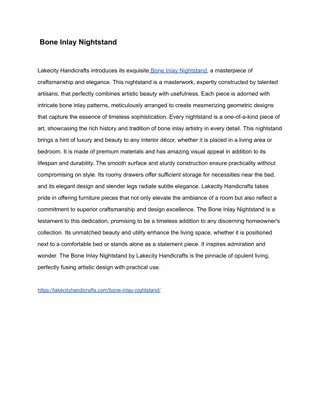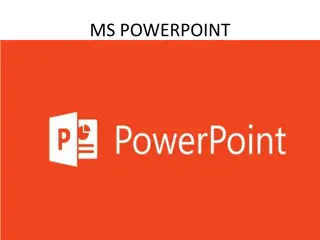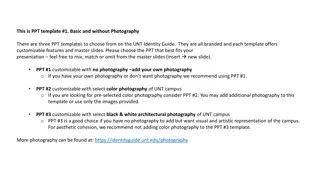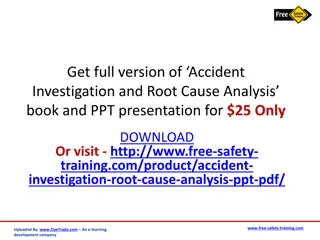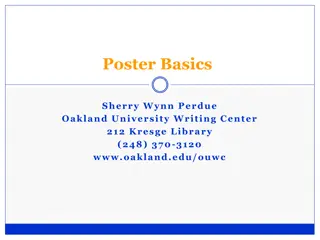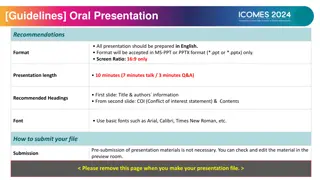
Exploring Advanced Methods and Analysis in Learning and Social Sciences
Delve into the realm of advanced methods and analysis for the learning and social sciences with a fresh perspective on the importance of understanding tests and their applications. Discover the key to utilizing the right tests with the correct assumptions for effective research outcomes.
Download Presentation

Please find below an Image/Link to download the presentation.
The content on the website is provided AS IS for your information and personal use only. It may not be sold, licensed, or shared on other websites without obtaining consent from the author. If you encounter any issues during the download, it is possible that the publisher has removed the file from their server.
You are allowed to download the files provided on this website for personal or commercial use, subject to the condition that they are used lawfully. All files are the property of their respective owners.
The content on the website is provided AS IS for your information and personal use only. It may not be sold, licensed, or shared on other websites without obtaining consent from the author.
E N D
Presentation Transcript
Advanced Methods and Analysis for the Learning and Social Sciences PSY505 Spring term, 2012 April 26, 2012
Todays Class Frequentist Statistics not Frequently Covered in 21stCentury Textbooks
Could cover a lot of methods With a ton of math
Instead I d like to try to make a different point
You dont need to know The math behind every test
You dont need to know The math behind every test Will you even remember it?
You dont need to know The math behind every test Will you even remember it? If so, you have a better memory than me!
What you need to know What tests are out there Enough math to be able to learn those tests when you need them Many are in SSPS Still good to know enough math to make sure that you are using them right
Its all out there By now, there is a test for almost everything you might want to do Although it may be quite obscure
Its all out there By now, there is a test for almost everything you might want to do Although it may be quite obscure The Ferguson book I excerpted from is a great resource Another great resource is Sheskin s Handbook of Parametric and Nonparametric Statistical Procedures The Handbook of Research Synthesis by Cooper and Hedges is another nifty resource
The key thing Make sure you re doing the right test Right assumptions about type of independent variables type of dependent variables independence or lack thereof question you re asking
If you dont know what youre doing Read some more Ask somebody who has done similar tests in the past
So that said Let s play a game
So that said Let s play a game With candy!
Put away your laptops Or no candy for you!
What test do you use? If you want to compare means of two quantitative variables in two groups of students? (assuming no other variables as covariates, and that data is reasonably close to normal)
What test do you use? If you want to compare means of two quantitative variables in two groups of students? (assuming no other variables as covariates, and that data is reasonably close to normal) Two group t-test
What test do you use? If you want to compare means of two quantitative variables in two groups of students? (assuming no other variables as covariates, and that data is not close to normal)
What test do you use? If you want to compare means of two quantitative variables in two groups of students? (assuming no other variables as covariates, and that data is not close to normal) Wilcoxon Rank-Sum Test Variant exists for two variables in one group
What test do you use? If you want to compare means of two quantitative variables in two groups of students? (assuming no other variables as covariates, and that data is not close to normal) Wilcoxon Rank-Sum Test Variant exists for two variables in one group Wilcoxon Matched-Pairs Rank-Sum Test
What test do you use? If you want to compare means of two quantitative variables in the same group of students? (assuming no other variables as covariates)
What test do you use? If you want to compare means of two quantitative variables in the same group of students? (assuming no other variables as covariates) Paired t-test
What test do you use? If you want to statistically determine whether inter-rater reliability is higher than chance?
What test do you use? If you want to statistically determine whether inter-rater reliability is higher than chance? Friedman s test (Sometimes called Friedman s Chi-Squared)
What test do you use? If you want to statistically determine whether inter-rater reliability is higher than chance? When might this case come up?
What test do you use? If you want to statistically determine whether one correlation is higher than another correlation? (For different populations)
What test do you use? If you want to statistically determine whether one correlation is higher than another correlation? (For different populations) Significance of the Difference Between Two Correlation Coefficients for Independent Samples
What test do you use? If you want to statistically determine whether one correlation is higher than another correlation? (For different populations) When might this case come up?
What test do you use? If you want to statistically determine whether one correlation is higher than another correlation? (For the same population)
What test do you use? If you want to statistically determine whether one correlation is higher than another correlation? (For the same population) Significance of the Difference Between Two Correlation Coefficients for Correlated Samples
What test do you use? If you want to statistically determine whether one correlation is higher than another correlation? (For the same population) When might this case come up?
What test do you use? If you want to compare two proportions in two groups of students? (assuming no other variables as covariates)
What test do you use? If you want to compare two proportions in two groups of students? (assuming no other variables as covariates) Significance of the Difference Between Two Independent Proportions OR Chi-squared test, with df=1
What test do you use? If you want to compare two proportions in two groups of students? (assuming no other variables as covariates) When might this case come up?
What test do you use? If you want to compare two proportions in the same group of students? (assuming no other variables as covariates)
What test do you use? If you want to compare two proportions in the same group of students? (assuming no other variables as covariates) McNemar s test Also called the Significance of the Difference Between Two Correlated Proportions NOT Chi-squared!!!
What test do you use? If you want to compare two proportions in the same group of students? (assuming no other variables as covariates) When might this case come up?
What test do you use? If you want to determine whether one variance is significantly different than another variance?
What test do you use? If you want to determine whether one variance is significantly different than another variance? Significance of the Difference Between Variances for {Independent, Correlated} Samples
What test do you use? If you want to determine whether one variance is significantly different than another variance? When might this case come up?
What test do you use? If you want to determine whether a process that would occur 50% of the time by chance, actually occurs more or less than 50%?
What test do you use? If you want to determine whether a process that would occur 50% of the time by chance, actually occurs more or less than 50%? Sign test
What test do you use? If you want to determine whether a process that would occur 50% of the time by chance, actually occurs more or less than 50%? When might this case come up?
What test do you use? If you want to determine whether a process that would occur 50% of the time by chance, actually occurs more or less than 50%? http://www.youtube.com/watch?v=NbInZ5oJ0bc
Other Tests Are there any situations you ve come up with during your studies Where there is a weird data situation And you need an appropriate test But you don t know what to do? Maybe I have some ideas Or one of your classmates
More Than 10 Minutes Left? Strube s Adjusted Z!
Last Class Monday, April 30 3pm-5pm AK232 Ensemble Selection Methods Special Guest Lecture: Zachary Pardos Readings Caruana, R., Niculescu-Mizil, A., Crew, G., Ksikes, A. (2004) Ensemble selection from libraries of models. Proceedings of the twenty first International Conference on Machine Learning. Pardos, Z.A., Baker, R.S.J.d., Gowda, S.M., Heffernan, N.T. (in press) The Sum is Greater than the Parts: Ensembling Models of Student Knowledge in Educational Software. To appear in SIGKDD Explorations. Assignments Due: None







